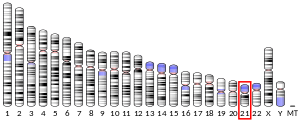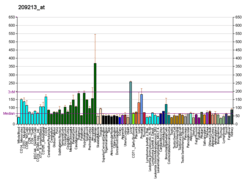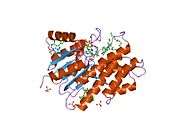CBR1
Carbonyl reductase 1, also known as CBR1, is an enzyme which in humans is encoded by the CBR1 gene.[4][5][6] The protein encoded by this gene belongs to the short-chain dehydrogenases/reductases (SDR) family, which function as NADPH-dependent oxidoreductases having wide specificity for carbonyl compounds, such as quinones, prostaglandins, and various xenobiotics. Alternatively spliced transcript variants have been found for this gene.[4]
Function
Carbonyl reductase is one of several monomeric, NADPH-dependent oxidoreductases having wide specificity for carbonyl compounds. This enzyme is widely distributed in human tissues. Another carbonyl reductase gene, CBR3, lies close to this gene on chromosome 21q.[4] CBR1 metabolizes many toxic environmental quinones and pharmacological relevant substrates such as the anticancer doxorubicin.[7] Several studies have shown that CBR1 plays a protective role in oxidative stress, neurodegeneration, and apoptosis.[8] In addition, CBR1 inactivates lipid aldehydes during oxidative stress in cells. Therefore, CBR1 may play a beneficial role in protecting against cellular damage resulting from oxidative stress.[9]
Polymorphisms
Up-to-date two non-synonymous polymorphisms on CBR1 have been identified. The CBR1 V88I polymorphism encodes for a valine-to-isoleucin substitution at position 88 of the aminoacid chain. In vitro studies with recombinant proteins indicate that the CBR1 V88 isoform has a higher Vmax towards the substrates menadione (vitamin K3) and daunorubicin.[10] Recent studies in human liver cytosols show that an untranslated polymorphism on the 3'UTR region of the CBR1 gene (rs9024)[11] is associated with higher levels of the cardiotoxic metabolite doxorubicinol.[12]
Structure
Gene
Human CBR1 gene maps to chromosome 21 at q22.13, and includes 8 exons.[4]
Protein
The enzyme consists of 277 amino acid residues and is widely distributed in human tissues such as liver, epidermis, stomach, small intestine, kidney, neuronal cells, and smooth muscle fibers.[13] The best substrates of CBR1 are quinones, including ubiquinone-1 and tocopherolquinone (vitamin E). Ubiquinones (coenzyme Q) are constitutive parts of the respiratory chain, and tocopherolquinone protects lipids of biological membranes against lipid peroxidation, indicating that CBR1 may play an important role as an oxidation–reduction catalyst in biological processes.[14]
Clinical significance
CBR1 has been reported to relate to tumor progression.[15] Suppression of CBR1 expression was associated with poor prognosis in uterine endometrial cancer and uterine cervical squamous cell carcinoma.[15] Previous studies showed that decreased CBR1 expression is associated with lymph node metastasis and poor prognosis in ovarian cancer, and induction of CBR1 expression in ovarian tumors leads to a spontaneous decrease in tumor size.[16]
Recent study demonstrates that CBR1 attenuates apoptosis and promotes cell survival in pancreatic β cell lines under glucotoxic and glucolipotoxic conditions via reducing ROS generation. Their data demonstrates that CBR1 expression level and enzyme activity are decreased in pancreatic islets isolated from db/db mice, an animal model of type 2 diabetes. These results suggest that CBR1 may play a role in protecting pancreatic β-cells against oxidative stress under glucotoxic or glucolipotoxic conditions, and its reduced expression or activity may contribute to β-cell dysfunction in db/db mice or human type 2 diabetes.[13]
In addition, CBR1 may play a critical role in PGF2α synthesis in human amnion fibroblasts, and cortisol promotes the conversion of PGE2 into PGF2α via glucocorticoid receptor (GR)-mediated induction of CBR1 in human amnion fibroblasts. This stimulatory effect of cortisol on CBR1 expression may partly explain the concurrent increases of cortisol and PGF2α in human amnion tissue with labor, and these findings may account for the increased production of PGF2α in the fetal membranes prior to the onset of labor.[17]
Interactions
CBR1 has been shown to interact with Cortisol,[17] C2 domain,[18] and Flavonoid.[19]
References
- GRCh38: Ensembl release 89: ENSG00000159228 - Ensembl, May 2017
- "Human PubMed Reference:". National Center for Biotechnology Information, U.S. National Library of Medicine.
- "Mouse PubMed Reference:". National Center for Biotechnology Information, U.S. National Library of Medicine.
- "Entrez Gene: CBR1 carbonyl reductase 1".
- Lemieux N, Malfoy B, Forrest GL (Jan 1993). "Human carbonyl reductase (CBR) localized to band 21q22.1 by high-resolution fluorescence in situ hybridization displays gene dosage effects in trisomy 21 cells". Genomics. 15 (1): 169–72. doi:10.1006/geno.1993.1024. PMID 8432528.
- Persson B, Kallberg Y, Bray JE, Bruford E, Dellaporta SL, Favia AD, Duarte RG, Jörnvall H, Kavanagh KL, Kedishvili N, Kisiela M, Maser E, Mindnich R, Orchard S, Penning TM, Thornton JM, Adamski J, Oppermann U (Mar 2009). "The SDR (short-chain dehydrogenase/reductase and related enzymes) nomenclature initiative". Chemico-Biological Interactions. 178 (1–3): 94–8. doi:10.1016/j.cbi.2008.10.040. PMC 2896744. PMID 19027726.
- Wermuth B, Platts KL, Seidel A, Oesch F (Apr 1986). "Carbonyl reductase provides the enzymatic basis of quinone detoxication in man". Biochemical Pharmacology. 35 (8): 1277–82. doi:10.1016/0006-2952(86)90271-6. PMID 3083821.
- Ismail E, Al-Mulla F, Tsuchida S, Suto K, Motley P, Harrison PR, Birnie GD (Mar 2000). "Carbonyl reductase: a novel metastasis-modulating function". Cancer Research. 60 (5): 1173–6. PMID 10728668.
- Maser E (Feb 2006). "Neuroprotective role for carbonyl reductase?". Biochemical and Biophysical Research Communications. 340 (4): 1019–22. doi:10.1016/j.bbrc.2005.12.113. PMID 16406002.
- Gonzalez-Covarrubias V, Ghosh D, Lakhman SS, Pendyala L, Blanco JG (Jun 2007). "A functional genetic polymorphism on human carbonyl reductase 1 (CBR1 V88I) impacts on catalytic activity and NADPH binding affinity". Drug Metabolism and Disposition. 35 (6): 973–80. doi:10.1124/dmd.107.014779. PMC 2442771. PMID 17344335.
- "Reference SNP Cluster Report: rs9024". Entrez SNP. National Center for Biotechnology Information/National Institutes of Health.
- Gonzalez-Covarrubias V, Zhang J, Kalabus JL, Relling MV, Blanco JG (Feb 2009). "Pharmacogenetics of human carbonyl reductase 1 (CBR1) in livers from black and white donors". Drug Metabolism and Disposition. 37 (2): 400–7. doi:10.1124/dmd.108.024547. PMC 2680526. PMID 19022938.
- Rashid MA, Lee S, Tak E, Lee J, Choi TG, Lee JW, Kim JB, Youn JH, Kang I, Ha J, Kim SS (Nov 2010). "Carbonyl reductase 1 protects pancreatic β-cells against oxidative stress-induced apoptosis in glucotoxicity and glucolipotoxicity". Free Radical Biology & Medicine. 49 (10): 1522–33. doi:10.1016/j.freeradbiomed.2010.08.015. PMID 20728534.
- Wermuth B (Feb 1981). "Purification and properties of an NADPH-dependent carbonyl reductase from human brain. Relationship to prostaglandin 9-ketoreductase and xenobiotic ketone reductase". The Journal of Biological Chemistry. 256 (3): 1206–13. PMID 7005231.
- Murakami, A; Yakabe, K; Yoshidomi, K; Sueoka, K; Nawata, S; Yokoyama, Y; Tsuchida, S; Al-Mulla, F; Sugino, N (1 October 2012). "Decreased carbonyl reductase 1 expression promotes malignant behaviours by induction of epithelial mesenchymal transition and its clinical significance". Cancer Letters. 323 (1): 69–76. doi:10.1016/j.canlet.2012.03.035. PMID 22542806.
- Osawa, Y; Yokoyama, Y; Shigeto, T; Futagami, M; Mizunuma, H (March 2015). "Decreased expression of carbonyl reductase 1 promotes ovarian cancer growth and proliferation". International Journal of Oncology. 46 (3): 1252–8. doi:10.3892/ijo.2014.2810. PMID 25572536.
- Guo, C; Wang, W; Liu, C; Myatt, L; Sun, K (August 2014). "Induction of PGF2α synthesis by cortisol through GR dependent induction of CBR1 in human amnion fibroblasts". Endocrinology. 155 (8): 3017–24. doi:10.1210/en.2013-1848. PMC 4098009. PMID 24654784.
- Yagi, H; Conroy, PJ; Leung, EW; Law, RH; Trapani, JA; Voskoboinik, I; Whisstock, JC; Norton, RS (16 October 2015). "Structural Basis for Ca2+-mediated Interaction of the Perforin C2 Domain with Lipid Membranes". The Journal of Biological Chemistry. 290 (42): 25213–26. doi:10.1074/jbc.m115.668384. PMC 4646173. PMID 26306037.
- Nelson, SH; Grunebaum, H (April 1971). "A follow-up study of wrist slashers". The American Journal of Psychiatry. 127 (10): 1345–9. doi:10.1176/ajp.127.10.1345. PMID 5549925.
External links
Further reading
- Wirth H, Wermuth B (Dec 1992). "Immunohistochemical localization of carbonyl reductase in human tissues". The Journal of Histochemistry and Cytochemistry. 40 (12): 1857–63. doi:10.1177/40.12.1453004. PMID 1453004.
- Inazu N, Ruepp B, Wirth H, Wermuth B (Mar 1992). "Carbonyl reductase from human testis: purification and comparison with carbonyl reductase from human brain and rat testis". Biochimica et Biophysica Acta (BBA) - General Subjects. 1116 (1): 50–6. doi:10.1016/0304-4165(92)90127-g. PMID 1540623.
- Forrest GL, Akman S, Doroshow J, Rivera H, Kaplan WD (Oct 1991). "Genomic sequence and expression of a cloned human carbonyl reductase gene with daunorubicin reductase activity". Molecular Pharmacology. 40 (4): 502–7. PMID 1921984.
- Forrest GL, Akman S, Krutzik S, Paxton RJ, Sparkes RS, Doroshow J, Felsted RL, Glover CJ, Mohandas T, Bachur NR (Apr 1990). "Induction of a human carbonyl reductase gene located on chromosome 21". Biochimica et Biophysica Acta (BBA) - Gene Structure and Expression. 1048 (2–3): 149–55. doi:10.1016/0167-4781(90)90050-c. PMID 2182121.
- Wermuth B, Platts KL, Seidel A, Oesch F (Apr 1986). "Carbonyl reductase provides the enzymatic basis of quinone detoxication in man". Biochemical Pharmacology. 35 (8): 1277–82. doi:10.1016/0006-2952(86)90271-6. PMID 3083821.
- Wermuth B, Bohren KM, Heinemann G, von Wartburg JP, Gabbay KH (Nov 1988). "Human carbonyl reductase. Nucleotide sequence analysis of a cDNA and amino acid sequence of the encoded protein". The Journal of Biological Chemistry. 263 (31): 16185–8. PMID 3141401.
- Bohren KM, von Wartburg JP, Wermuth B (May 1987). "Kinetics of carbonyl reductase from human brain". The Biochemical Journal. 244 (1): 165–71. doi:10.1042/bj2440165. PMC 1147968. PMID 3311025.
- Wermuth B (Feb 1981). "Purification and properties of an NADPH-dependent carbonyl reductase from human brain. Relationship to prostaglandin 9-ketoreductase and xenobiotic ketone reductase". The Journal of Biological Chemistry. 256 (3): 1206–13. PMID 7005231.
- Wermuth B, Mäder-Heinemann G, Ernst E (Mar 1995). "Cloning and expression of carbonyl reductase from rat testis". European Journal of Biochemistry / FEBS. 228 (2): 473–9. doi:10.1111/j.1432-1033.1995.tb20286.x. PMID 7705364.
- Krook M, Ghosh D, Strömberg R, Carlquist M, Jörnvall H (Jan 1993). "Carboxyethyllysine in a protein: native carbonyl reductase/NADP(+)-dependent prostaglandin dehydrogenase". Proceedings of the National Academy of Sciences of the United States of America. 90 (2): 502–6. doi:10.1073/pnas.90.2.502. PMC 45691. PMID 8421682.
- Lemieux N, Malfoy B, Forrest GL (Jan 1993). "Human carbonyl reductase (CBR) localized to band 21q22.1 by high-resolution fluorescence in situ hybridization displays gene dosage effects in trisomy 21 cells". Genomics. 15 (1): 169–72. doi:10.1006/geno.1993.1024. PMID 8432528.
- Watanabe K, Sugawara C, Ono A, Fukuzumi Y, Itakura S, Yamazaki M, Tashiro H, Osoegawa K, Soeda E, Nomura T (Aug 1998). "Mapping of a novel human carbonyl reductase, CBR3, and ribosomal pseudogenes to human chromosome 21q22.2". Genomics. 52 (1): 95–100. doi:10.1006/geno.1998.5380. PMID 9740676.
- Tinguely JN, Wermuth B (Feb 1999). "Identification of the reactive cysteine residue (Cys227) in human carbonyl reductase". European Journal of Biochemistry / FEBS. 260 (1): 9–14. doi:10.1046/j.1432-1327.1999.00089.x. PMID 10091578.
- Finckh C, Atalla A, Nagel G, Stinner B, Maser E (Jan 2001). "Expression and NNK reducing activities of carbonyl reductase and 11beta-hydroxysteroid dehydrogenase type 1 in human lung". Chemico-Biological Interactions. 130-132 (1–3): 761–73. doi:10.1016/S0009-2797(00)00306-9. PMID 11306092.
- Balcz B, Kirchner L, Cairns N, Fountoulakis M, Lubec G (2002). "Increased brain protein levels of carbonyl reductase and alcohol dehydrogenase in Down syndrome and Alzheimer's disease". Journal of Neural Transmission. Supplementum (61): 193–201. doi:10.1007/978-3-7091-6262-0_15. ISBN 978-3-211-83704-7. PMID 11771743.
- Skálová L, Nobilis M, Szotáková B, Kondrová E, Savlík M, Wsól V, Pichard-Garcia L, Maser E (Jul 2002). "Carbonyl reduction of the potential cytostatic drugs benfluron and 3,9-dimethoxybenfluron in human in vitro". Biochemical Pharmacology. 64 (2): 297–305. doi:10.1016/S0006-2952(02)01068-7. PMID 12123751.
- Cheon MS, Shim KS, Kim SH, Hara A, Lubec G (Jul 2003). "Protein levels of genes encoded on chromosome 21 in fetal Down syndrome brain: Challenging the gene dosage effect hypothesis (Part IV)". Amino Acids. 25 (1): 41–7. doi:10.1007/s00726-003-0009-9. PMID 12836057.




